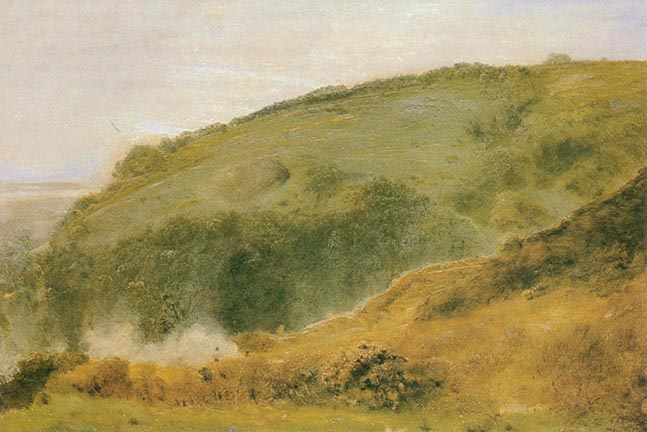
The Quantock Hills, Somerset by John William North, ARA, RWS (1842-1924). Oil on canvas; 20 x 30 Y2 inches. Signed 'J. W. North ARA' and dated 1903 at lower left; inscribed with title on a label on the frame. Provenance: John A. Cooling
Commentary by Christopher Newall
J. W. North was a landscape painter in water colour and occasionally oil, and, in addition, the finest landscapist amongst the illustrators of the 1860s. He was born in London, and, after a childhood made insecure by his father's bankruptcy, he was, in 1860, apprenticed to the wood engraver J. W. Whymper. This event led to his close friendship with Fred Walker, Arthur Boyd Houghton and George John Pinwell; subsequently they all worked together for Dalziel's. From 1868 North lived in Somerset, at first with Fred Walker at Halsway Manor, and from this stage on his landscapes are almost invariably taken from the Quantock Hills and neighbouring countryside. In 1928 the painter Herbert Alexander wrote of his old friend:
John William North on my return from a visit to his painting-grounds in that loveliest region of England which lies between the Quantock Hills and the Severn sea; undulating country that slopes from uplands of pasture and furze common down through orchards and crops to fall into wooded valleys where wind the sweetest fern-fringed streams. Intricate lanes burrow their way in deep grooves between banks or red earth which are overhung with canopies of greenwood festooned with sprays of honeysuckle, dog-rose and the wild clematis. [p. 35]
Many artists, some better known than North himself, visited him in Somerset and were inspired both by his technique and his vision of landscape. North's humility before nature and ingenuousness of personality distinguish his landscape painting from that of his contemporaries to the end of his long life. Alexander wrote of his method:
North's interpretation of nature was that of a poet. He did not sit down, like the average landscape painter, in picturesque scenery and arrange it improvingly; but living his life full of varied interests he waited until an entrancing moment in the passage of light or some human episode happily related to its surroundings awoke in his heart the ecstasy which is the poetic state. Then no sacrifice of time or labour was too great in the searching of nature to aid his revelation. [p. 48]
North survived his illustrator friends Walker, Pinwell and Houghton, each of whom died in 1875, by nearly half a century; he died in Stanborough, Somerset, in 1924.
Oil paintings, such as the present, represent a relatively small part of North's output, despite his aptitude for the medium. Alexander wrote:
I think it was G. F. Watts who first encouraged him to experiment in oils. North told me that his "oil" technique was an endeavour to get as near as possible to the effect of water colour which he considered a less encumbered means of expression. Having prepared his canvas with a ground of Chinese white he rubbed in with warm colour the masses of his composition, then with a very liquid medium of his own called "papoma" he washed in the sky and gave atmosphere to his forms with powder colours, finally glazing the full passages as though he were enamelling. In water colour and oil an effect of intricate detail is found on examination to be quite illusive — multitudinous form is conjured by finding and losing it in endless hide-and-seek till the eye accepts infinity. [p. 48]
References
Alexander, Herbert. "John William North, ARA, RWS." The Old Water-colour Society's Club, Fifth Annual Volume. London: 1928.
Newall, Christopher. A Celebration of British and European Painting of the 19th and 20th Centuries. London: Peter Nahum, nd.
Peter Nahum Ltd, London has most generously given its permission to use in the Victorian Web information, images, and text from its catalogues, and this generosity has led to the creation of hundreds of the site's most valuable documents on painting, drawing, and sculpture. The copyright on text and images from their catalogues remains, of course, with Peter Nahum Ltd.
Readers should consult the website of Peter Nahum at the Leicester Galleries to obtain information about recent exhibitions and to order their catalogues. [GPL]
Last modified 1 August 2001